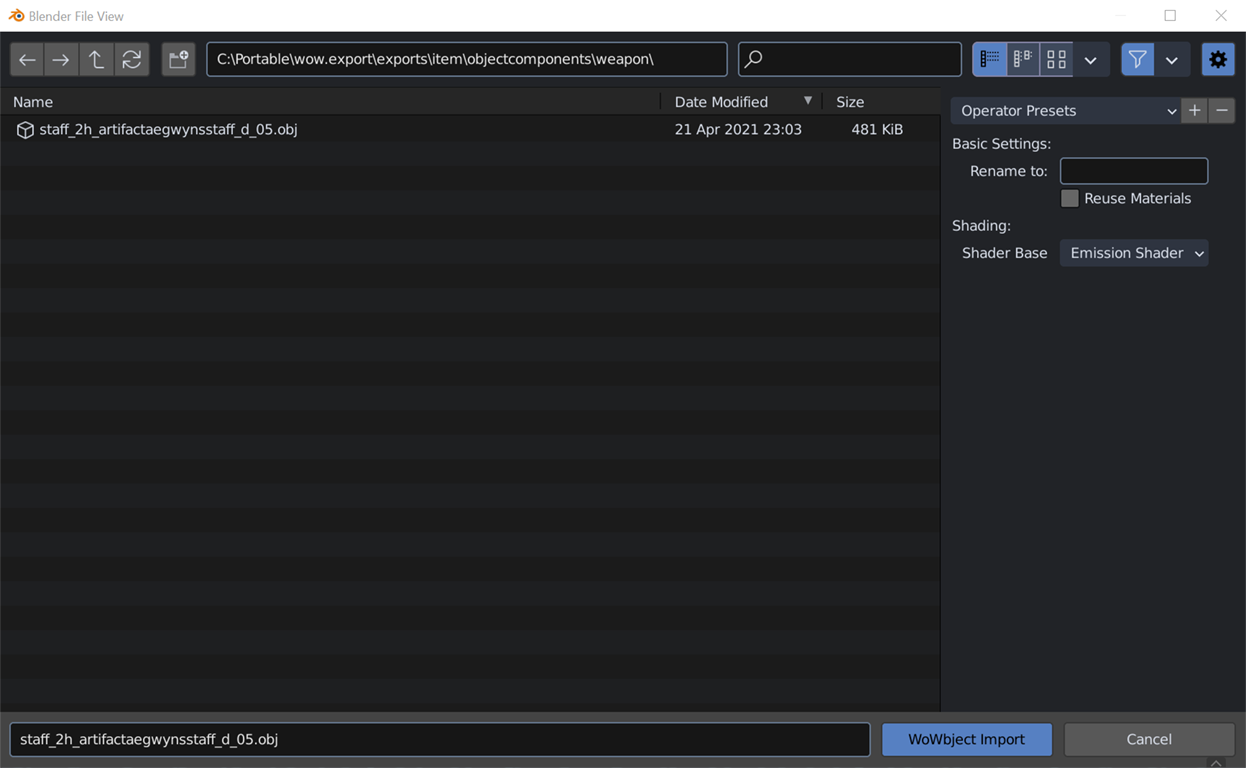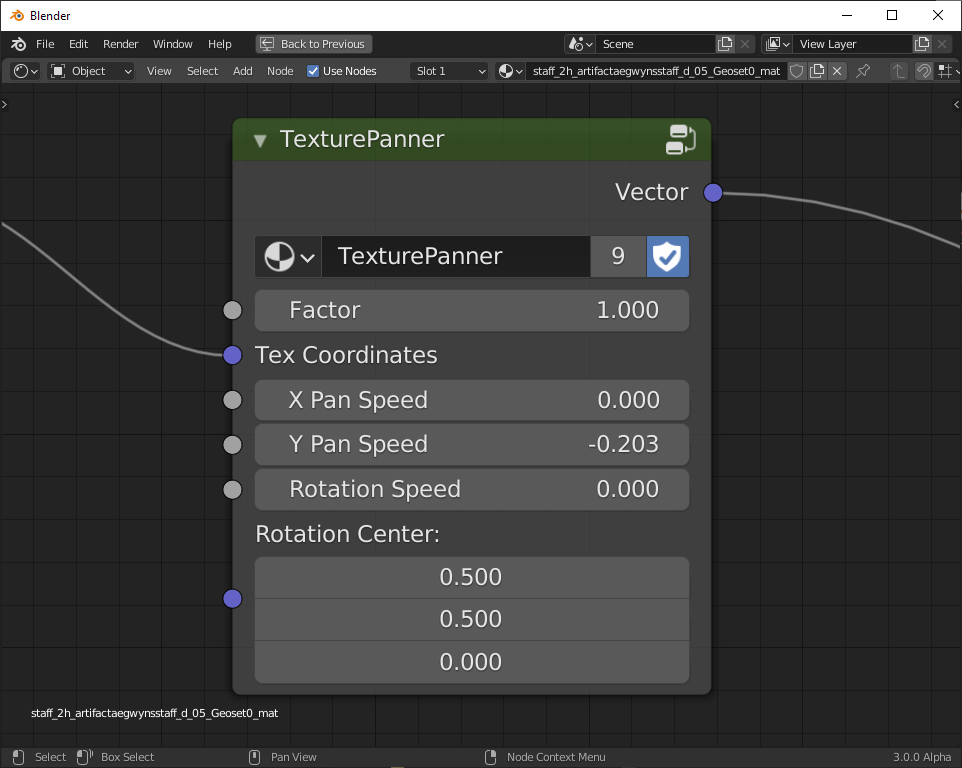TL;DR: This Blender add-on + WoW.Export = Streamlined import and material assignment with accurate shaders and animated UVs, with more features to come. This add-on requires files exported via wow.export and will not work with files exported from WoW via other methods. Be sure to read Using, below.
-
M2 Imports (Objects, NPCs, Creatures, Weapons, Armor, Skyboxes, etc)
- Automatically applies game textures and materials, using game-accurate shaders, reproduced using standard Blender node trees
- This includes properly mapped specular highlights (via the standard WoW
armorreflecttextures) - Automatically sets up UV animations (for magic effects, etc) to animate in the correct ways, with correct timings
- Allows your choice of emissive shaders (most true to WoW), diffuse shaders, specular shaders, or the principled shader
- Optional duplicate vertex deduplication (WARNING: Will prevent the binding of the object to a separately imported armature)
-
WMO Imports (WoW Map Objects -- Buildings and Architecture)
- Automatically applies game textures and materials (which, because WoW is WoW, is done completely differently from M2 models)
- Emissive map components (e.g. lit windows) are properly created as emissive textures (though they will only illuminate their surroundings when rendering with Cycles, not Eevee)
- Imported WMOs are split into individual 'building block' objects by group (generally individual buildings or small groups of buildings in larger WMOs like cities)
- Individual building block objects are grouped into collections (by general classification, usually, e.g. different districts in Stormwind) when possible. Only a limited number of WMO files support this.
- Each building block is given an origin at the center of its bounding box (we are open to suggestions for a better selection of origin points)
- Optional duplicate vertex deduplication (strongly recommended -- most WMO models have a large number of duplicate vertices and many disconnected faces)
-
M2 Imports
- Animation beyond UV animation is not currently supported (planned)
- Particle and ribbon effects are not currently supported (planned)
- Player character imports are not supported (other than being able to import the base components as any other objects)
- "billboard" textures and sub-meshes (ones where the same side always "faces" the camera) are not currently supported. (planned)
- Some types of model have not been well-tested (but we'd really like to hear about failures if you encounter them)
- Models that originated in older expansions may or may not import correctly (please report this if you run into it)
- We have not done exhaustive testing of every individual shader, it's possible some are not implemented completely correctly (please report this)
- Objects that are themselves translucent will not perfectly match in-game translucency effects, because Blender does not have all of the blending modes available to do so (a future release may provide some tooling for helping with this, especially if there is demand)
-
WMO Imports
- Doodads are not supported, though you can of course import them as M2 models and place them yourself (better support planned)
- Water and magma are not supported
- UV animations are not supported (planned)
- THe texturing behavior for WMOs is much different than for M2s, and our implementation is fairly young, so may have issues (please report)
-
ADT Imports (Map tiles, terrain height, WMO positioning)
- Not supported
-
Magic & Spell Effects
- Not supported (planned)
Things we are actively looking at doing in the near(ish) future:
- Item animations (spinning crystals, that kind of thing)
- Full monster/character animation support
- Simple particle effects (magic auras and such on items)
- Less-simple particle effects
- Magic & spell effects
- Automatic texture upscaling with correct handling of alpha channels
- Doodad support
- ADT support
- Other things that a human shouldn't have to do but currently have to (feel free to make suggestions)
Install as any other addon, access via File > Import > WoWbject. You will also need Kruithne's wonderful wow.export so that you'll be able to have something you can import. The WoWbject importer currently requires several features that are exclusive to wow.export, so don't try to use other export tools right now.
WoWbject Import is built to work with WoW.Export, and it reads both the JSON files that WoW.Export produces and the raw m2 files that it can export. You will need to install wow.export and have it configured in a specific way (in the wow.export settings page):
- Enable Shared Textures must be disabled
- Export Additional UV Layers must be enabled
- Export Meta Data must be enabled for at least M2 files
You will need to export the model twice: The importer needs two different types of files from wow.export, so Use "export as OBJ", followed by "export as M2 / WMO (Raw)". If you are in a hurry you can skip the M2/RAW step, though you will lose some features by doing so (primarily UV animation setup). We may remove the double-export requirement at some point in the future, but it's easy enough to do the double export that it's not at the top of our list.
WoW likes to store masks in alpha channels. This is especially prevalent with WMO assets, as they frequently use these masks to blend in (fairly subtle) reflection textures. While WoW.Export gives you the option to export textures without alpha, and WoWbject Import can usually piece together a reasonably accurate material setup with them, you'll lose out on the finer details.
Like most Blender importers, you'll find the WoWbject import operator in the File→Import menu. Click it, and it'll pop up a file browser that looks something like this:
Select the .obj file you want to import, pick what base shader configuration you want to use, click import, and you're good to go. For the closest to "in-game" texturing, the emission-based shader will be the best choice. If that shader doesn't meet your needs, give the others a try! The names are relatively self-explanatory, e.g. the 'diffuse' type uses a diffuse shader rather than an emissive one. Intuitive!
WoWbject relies on name matching to find the files it needs to import assets correctly. This means that the JSON, mtl, and m2 files that go with a particular .obj must have matching names. This is the normal behavior of wow.export if you don't rename any files after export.
The add-on will figure out which textures it should use, how they're combined, and if/how they use animated UVs based on what's in these files. It will also search for textures in a textures subdirectory, if one exists in the same directory as the .obj file being imported.
For assets that have UV animations, the add-on uses a driver inside of a node group, which means that, if you want to adjust the speed/direction of a UV animation, the settings are all on this node right here:
The node automatically compensates for the frame rate of the scene that is active when the object is imported. It does this by referencing the scene's frame rate in the driver that the add-on sets up. As a result, if you import an object with UV animations into one file, and then append that object into another file, it will also append the scene that the driver references. You will almost certainly want to avoid this by removing the driver from the node before appending an object to another scene.
The add-on preferences are relatively simple at the moment. Setting the Report Verbosity changes what kinds of reports the importer shows in the info editor, console, and status bar. It defaults to only showing warnings and errors. The updater settings control if and how frequently the add-on checks for updates, and are largely self-explanatory.
We want the WoWbject Importer to be as accurate as possible when importing objects from WoW. If you run into situations where you think the importer is doing the wrong thing, please open an issue on the WoWbject Importer issues page so that we can investigate!
We will also gladly accept feature requests via the same page. We can't guarantee we can implement everything requested, but we'll sure as heck give consideration to anything reasonable!
As with all Blender addons, the WoWbject Importer is licensed under the GNU GPL. See the included LICENSE for specifics.
This project was researched and beaten into existence through sheer force of will by TDV Alinsa, who then conscripted Asher Stephenson to do much of the heavy lifting. I think we were both surprised how deep this particular rabbit hole went!
Also, endless appreciation to Kruithne for both their awesome wow.export, and for tolerating way too many questions from Alinsa about various nitpicky WoW innards. By proxy, special thanks to Marlamin as well, creator of WoW Export Tools, on which wow.export is based.
(We are also intending to contribute our work back to Kruithne and the wow.export project after we've implemented more of what we intend to implement, and the dust has settled a bit.)
Many thanks to everyone who has contributed to the WoWDev wiki, for helping to provide an amazing resource for those who have come after them (like us). We build on the shoulders of giants.
This add-on relies on an external python module called kaitastruct, which it uses to read additional data from .m2 files. The module is bundled with the add-on — you don't need to install or configure anything — but makes possible some of the things this importer does. Check out the Kaitai Struct repo. It's an awesome project. You can also find our work-in-progress on defining WoW data structures with kaitai-struct in Alinsa's kaitai-warcraft repo.
And finally, many kudos to the Blender Foundation and the numerous contributors to the Blender project, for providing such amazing software for us to build on. For all its flaws, it is still amazing that software of this size and breadth is available for free to anyone who cares to use it.
- Asher's Patreon
- [Insert Social Media Here?]
v1.1.0:
- Fixed: Specular highlights ("armorreflect" textures) are more correct now
- Added: WMO support (see 'features' above)
- Added: Optional vertex deduplication
- Added: Optional tris-to-quads
- Added: render results test suite (see tests/README.md)
v1.0.0:
- Fixed: The importer can now handle meshes with duplicate faces
- Fixed: No longer explodes on OS X (file path handling)
- Changed: All reports are logged to the console, regardless of UI report settings
- Added: Can now set a default import directory
v0.9.0:
- First Release


